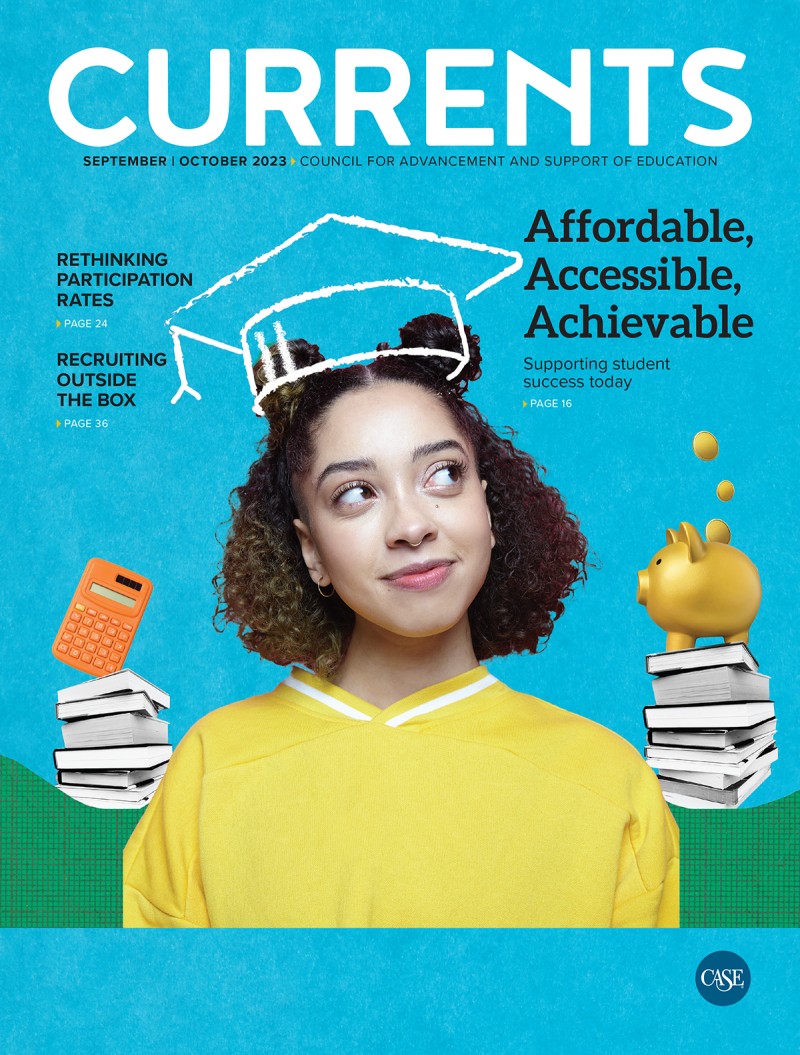
Participation is a metric we’re constantly pulling, quoting, celebrating, or mourning in our fundraising shops at independent schools. It measures how many people in a constituency are making gifts to a school’s annual fund or campaign. In U.S. independent day schools, roughly 60% of parents participate in our annual funds, while approximately 20% of alumni participate, according to the 2023 CASE Insights on Philanthropy in Independent Schools; boarding schools tend to see slightly lower parent participation than day schools. Single-gender schools see higher participation from both parents and alumni. Over the past five to seven years, we have seen those rates vary across school types by as much as 3% to 5% in either direction.
The topic of parent and alumni participation rates has been on my mind for some time. The essential question I want to pose to you—regardless of your school type or where it falls on the participation spectrum—is this: why is participation so central to our reporting and our thinking? And should it continue to be?
To answer these questions, let’s examine a key distinction between fundraising data analysis on a school level and overall benchmarking on a broader scale.
The practice of fundraising data analysis is constant: It is, among other things, a year-over-year, week-over-week look at progress made over time and against the school’s own progress in a similar period in the past. Analyzing your own school’s data is arguably the most important step to ensuring that you meet or exceed fundraising goals.
Benchmarking, by contrast, is generally a practice of looking at your school’s relative standing among a group of predetermined peers—such as institutions that are in your city or region, are the same school type, or have similar enrollment. Typically, benchmarking is a once- or twice-a-year activity. We engage in benchmarking to determine whether we’re hitting a relative regional, national, or global mark. We benchmark to determine if we are losing ground, if there are areas of opportunity, or if there is an aspect of our own program that exceeds that of our peers.
With our fundraising goals, we tend to look at parent and alumni participation in both of the above contexts. Did our participation go up or down relative to last year? Was it similar to participation at the school down the street? Our heads of school and our boards continually ask us to report on these data points and, if there has been a change in participation, discuss why and what it will mean for our annual fund goals the following year. According to the Data and Analysis for School Leadership team at the National Association of Independent Schools, participation was the number one most queried advancement data point in recent years. We know that this is a widely held convention; I talk to scores of advancement staff members at schools each year about their worries—or at least their boards’ worries—over participation rates.
But does participation actually tell us much about reaching or exceeding fundraising goals?
In essence, not by itself. We’ve been asking this one metric to pull more weight than it can carry, and I would suggest it’s time to turn our attention to more meaningful numbers and, in the process, educate our boards about what we should be asking.
CASE has been paving the way for this in recent years. For instance, the annual CASE Insights on Alumni Engagement Metrics (in which many schools participate) takes a holistic approach to engagement and measures not only philanthropic participation, but also volunteerism, experiential engagement, and communication engagement.
Participation is what I would call an indicative data point, not a predictive data point. When taken as a part of an overall evaluation of alumni or parent engagement with the school, participation can be indicative of that group’s overall demeanor toward an institution. In that context, participation can indicate how a group feels about your school or whether they are excited about leadership or the school’s mission. When considered in the context of something like CASE Insights on Alumni Engagement Metrics, these types of indicative data points can tell a powerful story. And this deep analysis is particularly valuable to an institution ahead of a campaign and strategic planning.
My concern for schools is not that they’re analyzing these types of indicative engagement metrics, merely that we’re confusing one of a host of engagement data points (which must be considered as part of a larger story) with predictive data points that can tell us more immediately where our annual fundraising progress is likely headed.
In essence, we need to stop asking this one participation data point to speak for our entire fundraising programs. We’ve been comparing apples to giraffes and it’s time we let each organism do its own work.
What, then, if you accept this as true, should we be measuring from a fundraising standpoint? What data points could we actually use to predict the strength of our fundraising programs over time? Here are five key questions I would encourage every school to consider.
-
What is your progress to goal?
This seems obvious, but it’s the most valuable lens to consider when predicting where you’ll land at the end of the fiscal year. If you haven’t made sufficient progress compared to previous years or where you hoped to be, it’s unlikely you’ll reach your goal in time. If you haven’t made sufficient progress to goal by a certain milestone, I encourage you to consider not only the below questions, but also whether your staff is appropriately sized, whether your budget is sufficient, or even whether your goals were set in a data-informed, collaborative way with the head of school, chief financial officer, and advancement team.
-
How do you set your leadership giving levels?
These range widely, depending on the level of affluence of the school, the school’s geography, the school type, or the founding date. One metric I would suggest is to start at 10% or more of tuition. In the U.S. specifically, philanthropy typically covers approximately 10% of the operating budget on a yearly basis. If that’s the case, then set leadership giving levels at a rate that contributes significantly to the bottom line and incentivizes both giving and constituents’ understanding of the fiscal role of philanthropy at the school.
-
What percentage of (new) families with capacity are assigned to a relationship manager?
Be aware of each of your families with capacity, especially if they are new to the school. Many schools wait to assign relationship managers to new families until after they’ve had time to “settle into” the community. I think that’s a mistake. First and foremost, all new families should be warmly welcomed into the school with personal attention by someone who can help them get the most out of the experience. For families with significant capacity, I would recommend that the welcome comes from someone either on the advancement team or deputized by the team to begin conversations about philanthropy early on. If you aren’t aware of who your new families with capacity are, I encourage you to employ either grassroots research or more sophisticated tools to assess that long before the first day of school.
-
What percentage of your annual fund is raised before the midway point in the school year?
I’ve observed how this metric has become increasingly important in recent years. When CASE conducted flash online surveys with our schools members during the pandemic, it was clear that those who had more than 50% to 75% of the annual fund raised or pledged before the midway point in the year were able to regularly meet or exceed their annual fund goals. Anecdotally, I have spoken with dozens of our members at schools who employed a “front-loading” strategy to their annual funds, focusing the bulk of their annual fund work in the first three months of the school year. These schools were able to significantly increase funds received over time.
This method is likely effective for two key reasons. First, staff are speaking with parents and alumni at a time when school is still fresh and exciting. There’s nostalgia at the beginning of a school year, and we can capitalize on that in attracting and retaining both goodwill and philanthropic support. Second, it requires a school to move event-based fundraising to the second half of the year. Events, as we know, generally raise less and are much more work for staff and volunteers than one-to-one cultivation and relationship building. If we are weighed down by these events early in the year, we may risk losing ground in developing both major gifts relationships and a culture of philanthropy at a crucial time.
-
What percentage of operational funds received (annual fund) are coming from your three largest donors, and do you have others in the pipeline to take their places?
This metric is important in considering future risk to your fundraising strength. Philanthropy has become increasingly top-heavy in schools. According to DASL, in 2022, CASE member schools reported that a staggering 43% of their total funds received were from their three largest donors. This statistic underscores the importance of our relationships with these donors and also suggests how vital it is to develop a pipeline of donors who can continue to fundraise at similar levels in the future. Pipeline development is an area where boards in particular can be highly influential and helpful to the advancement team and the school overall.
When I meet a school trustee, you can imagine how I deflate when their only question for me is how their school’s participation rates compare to similar schools nationally. It’s not, however, the trustee’s fault. Those who come from advancement backgrounds generally ask sophisticated questions. Those who don’t are asking the same questions their predecessors have asked. They’ve been conditioned (largely by us, the advancement shop!) to ask the participation question. Therefore, it is incumbent upon us to educate boards about participation, saying, “Yes, it’s valuable in the context of overall engagement metrics, but no, it’s not the only important metric. Yes, if taken in context, it can indicate either goodwill or hesitation to engage on the part of our constituents, but no, it’s not a specific forecast for our future annual giving success.”
It’s vital for your board members to understand the above metrics to help you develop the crucial pipelines that lead to success. It’s also important that they know what makes a sophisticated advancement program so they can support the school’s investment in philanthropy. And it’s essential they understand the difference between engagement metrics and fundraising metrics so they can develop a critical evaluation of both rather than confusing one for the other. This will lead to deeper work in both areas of advancement and ultimately toward a brighter future for the school.
So, let’s put participation rates in perspective by evaluating total engagement with the school and observing the correlation between overall engagement and philanthropy. You’ll gain essential insights in the process, and your integrated advancement efforts will be stronger as a result.
About the author(s)
Ann Snyder was Senior Director, Communities Engagement at Council for Advancement and Support of Education (CASE). Prior to joining CASE, she was Director of External Affairs at Stuart Hall School in Virginia, United States. With more than a decade of experience in student and family marketing, school leadership, enrolment, fundraising, and external affairs, Snyder is a seasoned school leader and industry expert.
In her role at CASE, Snyder served as the industry insider, expert, and thought leader for schools globally. Professional facilitation and speaking engagements included serving as a key speaker and collaborator for the Canadian Association of Independent Schools, the National Association of Independent Schools (U.S.), the Association of American Schools in South America, and regional associations throughout the United States.
Tags
Article appears in:

September - October 2023
Discover the Next stories highlight the value of higher education. Plus, strategies to build reputation, embracing transferable skills when recruiting, taking a fresh look at fundraising data, and more.


